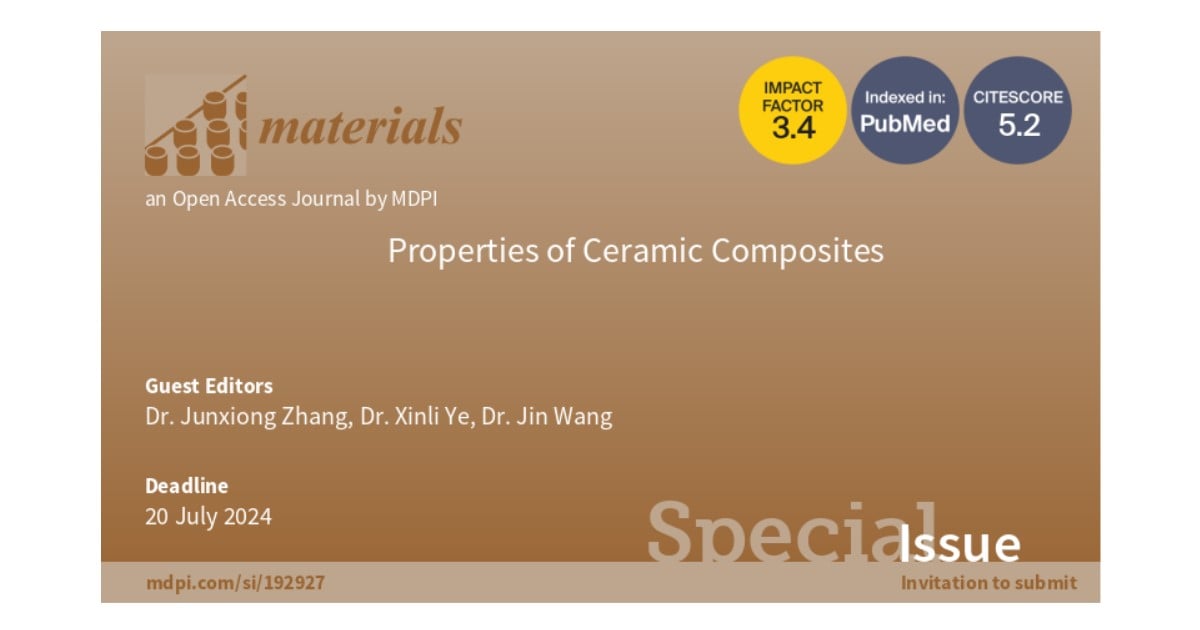Properties of Ceramic Composites
A special issue of Materials (ISSN 1996-1944). This special issue belongs to the section "Porous Materials".
Deadline for manuscript submissions: 20 July 2024 | Viewed by 1207

Special Issue Editors
Interests: aerogels; hydrogels; cyclodextrins; sol-gels; self-assembly; energy; enviroment; biomedical
Interests: ceramic matrix composites for electromagnetic wave absorption
Special Issues, Collections and Topics in MDPI journals
Special Issue Information
Dear Colleagues,
As a kind of key inorganic non-metallic material, ceramic plays a very important role in the development of modern industry. Therefore, the application of ceramic material should be paid attention to focus on. This special issue is focused on the research of ceramic material including but not limited to materials components, fabrication processes, testing equipment and/or methods, applications in thermodynamics, mechanical, electricity, absorption, sound insulation, electromagnetic wave shielding, piezoceramics, and so on. We cordially invite experts in the field of ceramic research to participate in this special issue and contribute manuscripts to us.
https://www.mdpi.com/journal/materials/special_issues/nanomaterials_asia
Dr. Jin Wang
Dr. Xinli Ye
Dr. Junxiong Zhang
Guest Editors
Manuscript Submission Information
Manuscripts should be submitted online at www.mdpi.com by registering and logging in to this website. Once you are registered, click here to go to the submission form. Manuscripts can be submitted until the deadline. All submissions that pass pre-check are peer-reviewed. Accepted papers will be published continuously in the journal (as soon as accepted) and will be listed together on the special issue website. Research articles, review articles as well as short communications are invited. For planned papers, a title and short abstract (about 100 words) can be sent to the Editorial Office for announcement on this website.
Submitted manuscripts should not have been published previously, nor be under consideration for publication elsewhere (except conference proceedings papers). All manuscripts are thoroughly refereed through a single-blind peer-review process. A guide for authors and other relevant information for submission of manuscripts is available on the Instructions for Authors page. Materials is an international peer-reviewed open access semimonthly journal published by MDPI.
Please visit the Instructions for Authors page before submitting a manuscript. The Article Processing Charge (APC) for publication in this open access journal is 2600 CHF (Swiss Francs). Submitted papers should be well formatted and use good English. Authors may use MDPI's English editing service prior to publication or during author revisions.
Keywords
- ceramic matrix composites
- ceramics
- ceramic fiber
- ceramic aerogel
Planned Papers
The below list represents only planned manuscripts. Some of these manuscripts have not been received by the Editorial Office yet. Papers submitted to MDPI journals are subject to peer-review.
Title: Effect of carbon black content and firing atmosphere on the properties and microstructure of Al2O3-SiC castables
Authors: /
Affiliation: Zhengzhou University
Abstract: /








